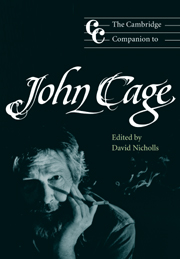Book contents
9 - Cage's collaborations
from Part III - Interaction and influence
Published online by Cambridge University Press: 28 September 2011
Summary
“It is not really natural for artists to work together . . . There is only one certainty: before the collaboration is through, you will have revealed yourselves to each other; you will be absolutely exposed. A certain blind courage is necessary . . . ”
(Graham 19 6 3, p. 4 )In the summer of 1952, a remarkable theatrical presentation took place in the dining hall of Black Mountain College in rural North Carolina. The audience – students and faculty at the school's summer session – were seated in a square broken by aisles into four triangles whose apexes merged toward the center. On each chair sat an empty cup, purpose unspecified; many people used them as ashtrays. John Cage (according to his recollections a decade later) stood on a ladder at one edge of the square dressed in a black suit reading from his “Juilliard Lecture.” Another ladder served as a podium for M. C. Richards and Charles Olson, who ascended it to read poetry. Suspended from the ceiling were four all-white paintings by Robert Rauschenberg, providing the backdrop for slides and a film by Nicholas Cernovitch. Rauschenberg stood below them operating an Edison horn record player, switching scratchy recordings on and off. Merce Cunningham danced down the aisles followed by a dog, and David Tudor played the piano. According to Cage, the performance lasted 45 minutes (the time it took to read his lecture), at the end of which the cups – even those used as ashtrays – were filled with coffee.
In later years, Cage's 1952 Black Mountain Piece would assume epic proportions, touted as the first of many mixed-media, multi-disciplinary, anti-establishment “happenings.” At the time, though, it seemed far less momentous. “I laughed a lot,” recalls Lou Harrison. “There was so much going on and it seemed so absurd” (Harrison 1995).
- Type
- Chapter
- Information
- The Cambridge Companion to John Cage , pp. 149 - 168Publisher: Cambridge University PressPrint publication year: 2002
- 3
- Cited by



